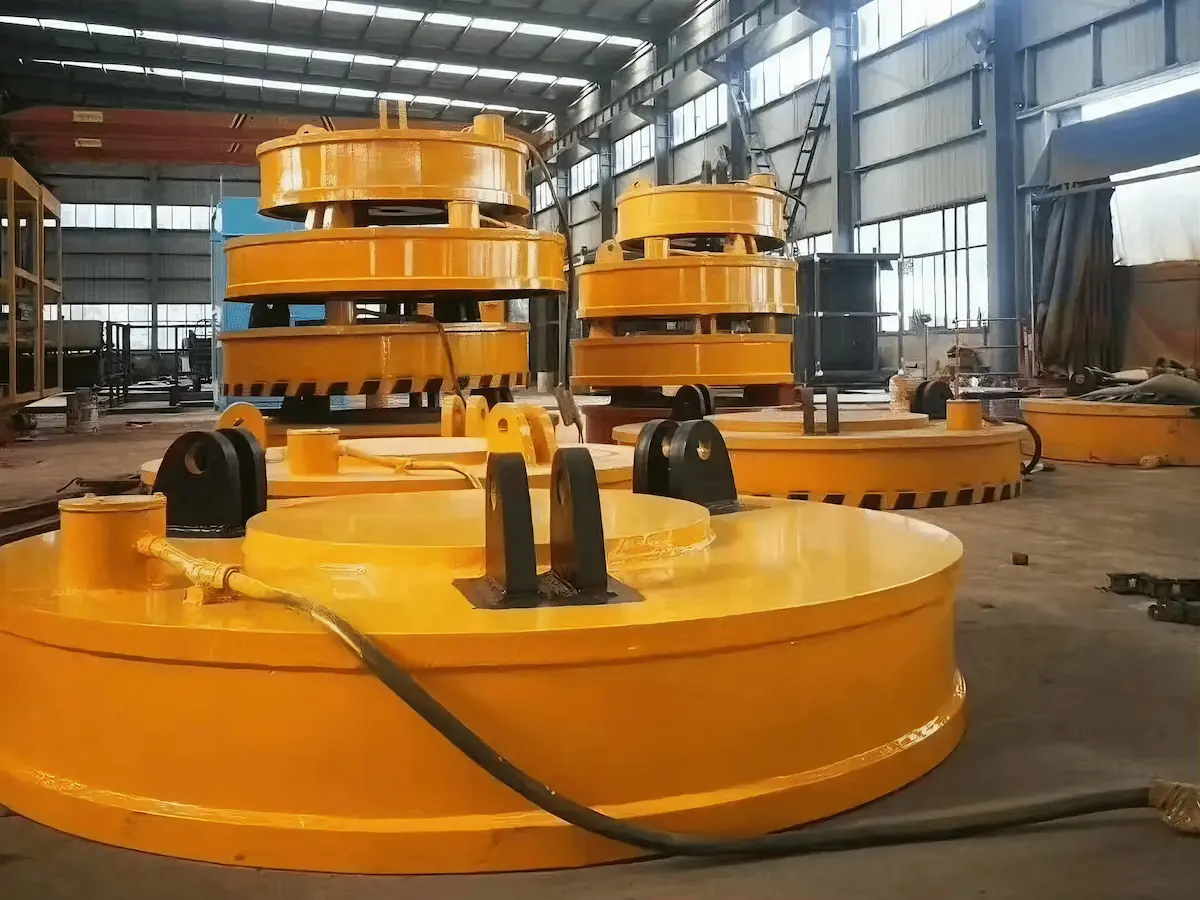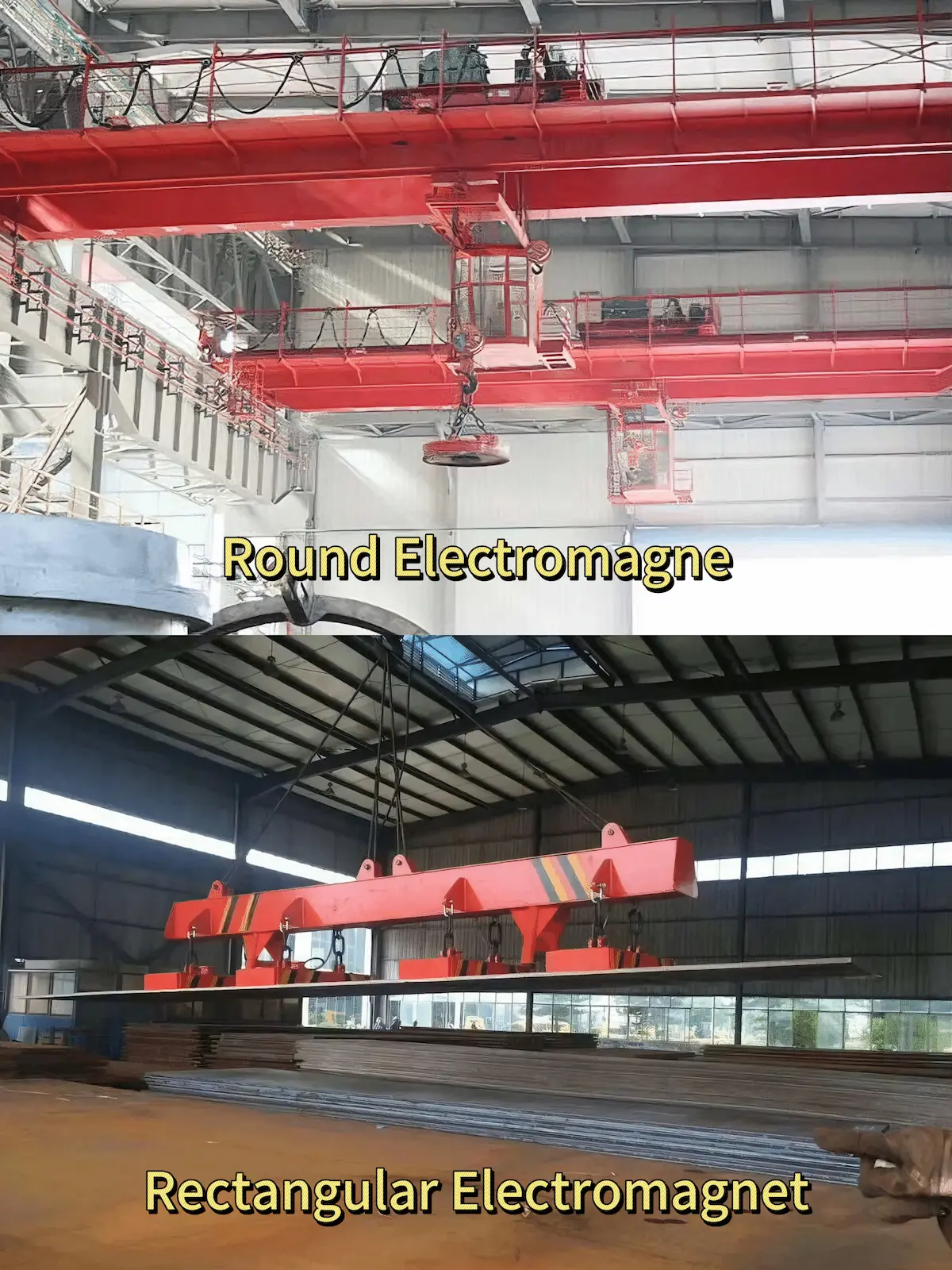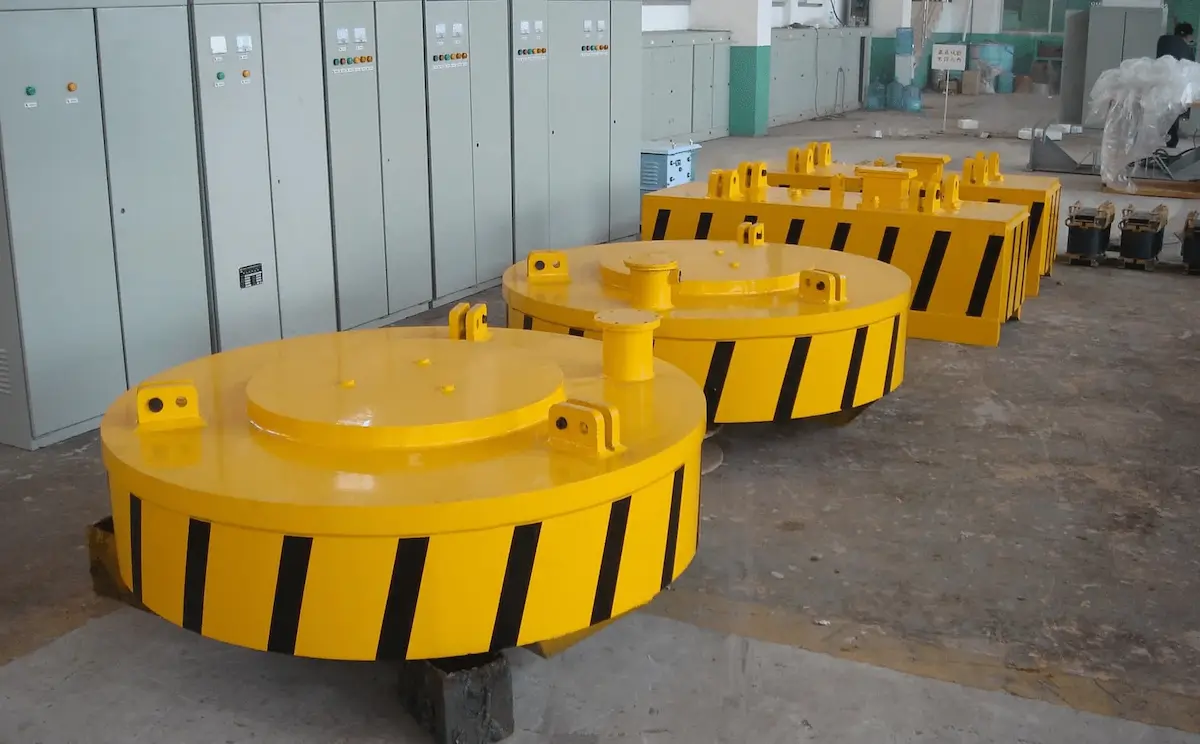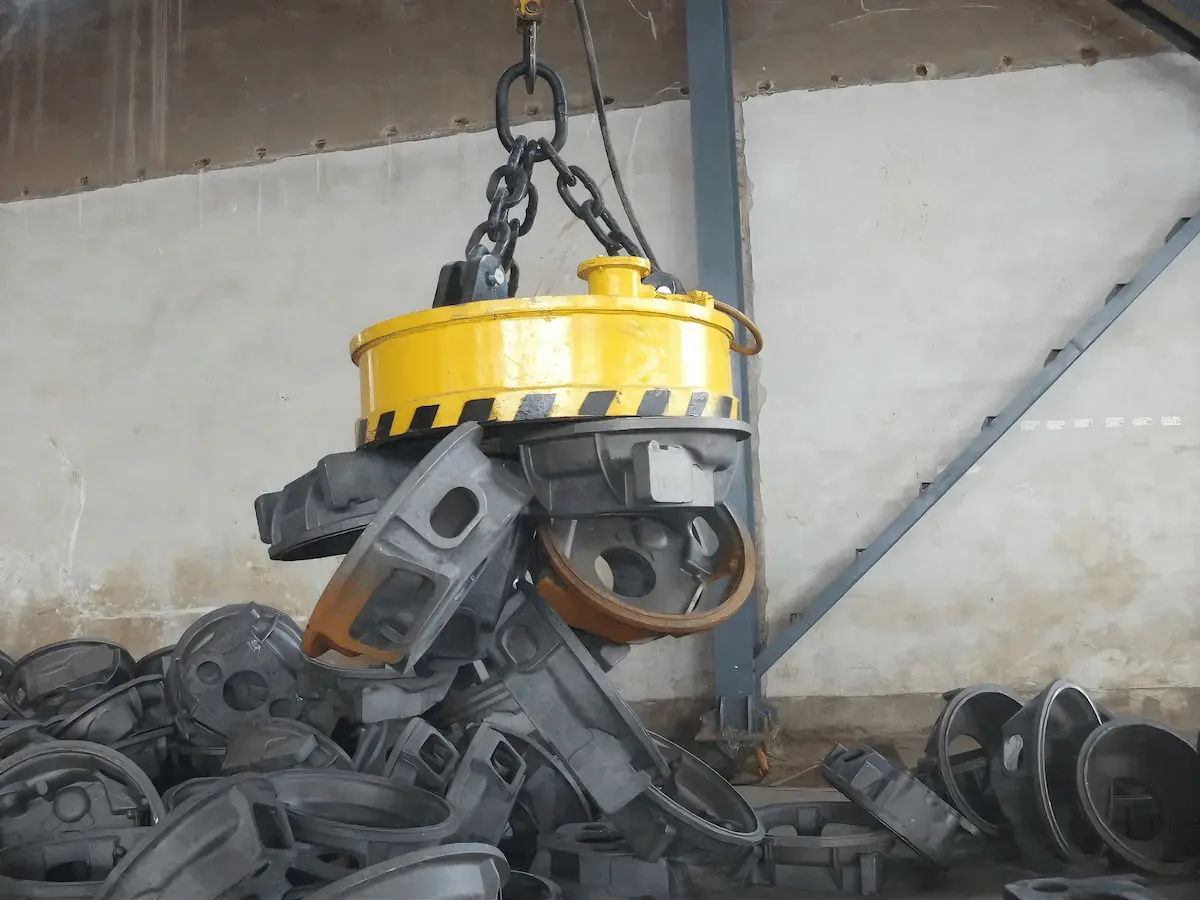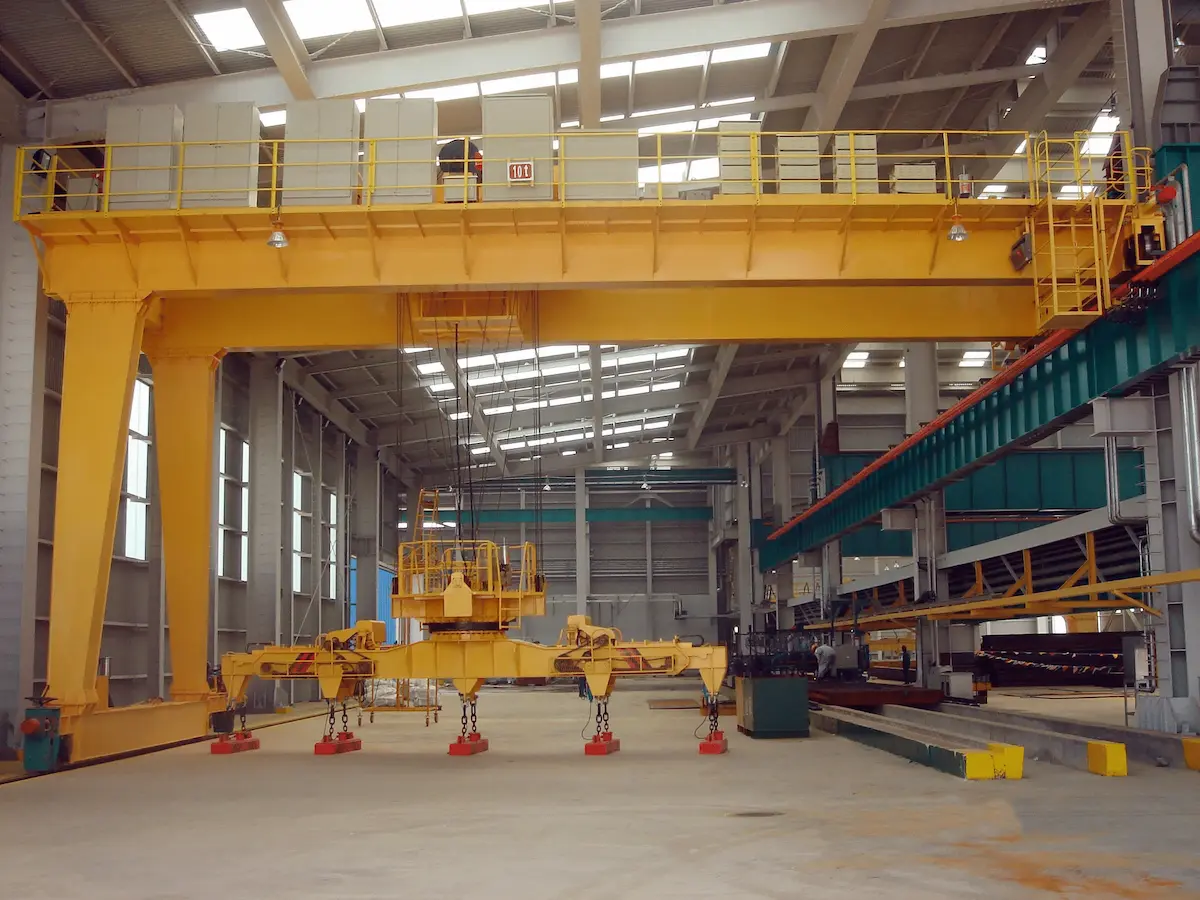In modern steel processing and logistics, electromagnets enable efficient handling of plates, profiles, and scrap steel. They use magnetic force for rapid pickup and release, improving automation and safety in material handling. Applications cover metallurgy, shipbuilding, machinery, and warehouse operations. However, magnet performance depends not only on magnetic strength or power supply. It is closely linked to the shape design of the electromagnet. Selecting between a Round vs Rectangular Electromagnet directly affects magnetic distribution, energy use, and lifting safety.
Structure and Working principle of Round vs Rectangular Electromagnet
Round Electromagnet
- Structural Features: A round electromagnet uses a circular coil core with a high-permeability iron shell. Its magnetic flux concentrates near the center, creating a dense, uniform magnetic field. The symmetrical design ensures balanced stress and stable vertical lifting performance. It is ideal for lifting medium or small steel plates, ingots, bars, and scrap.
- Working Principle: When energized, the coil generates a circular magnetic field through the iron core. Magnetic flux passes through the pole face, producing strong suction on ferromagnetic materials. When power is cut, the magnetic field disappears instantly, allowing quick and safe release. This electromagnetic lifting method offers fast response, adjustable force, and reliable safety.
Common Types:
Based on different working environments and conditions, round electromagnets are mainly classified into the following categories:
- Standard Round Electromagnet: Used for normal-temperature steel plates, profiles, and scrap. Easy maintenance and simple design.
- Deep Field Type: Features extended poles for greater magnetic penetration, suitable for thick or stacked materials.
- High-Temperature Resistant Type: Uses heatproof insulation and cooling systems for casting or hot rolling environments.
Rectangular Electromagnet
- Structural Features: A rectangular electromagnet consists of rectangular coils and high-permeability iron cores. The shell is reinforced and sealed for durability and protection. Compared to the round design, its magnetic poles form a wide, even field over large surfaces. This makes it ideal for handling long, flat, or multiple steel sections simultaneously. It provides high stability and efficient space utilization during lifting operations.
- Working Principle: When powered, magnetic flux flows through the rectangular magnetic circuit. A uniform magnetic channel covers the pole surface for consistent attraction. The strong field between the poles secures metal workpieces safely and efficiently. When the power is off, the magnetic field vanishes instantly for rapid material release.
- Common Types:
Based on application scenarios and control requirements, rectangular electromagnets are mainly divided into the following categories:
- Single-Pole Type: Lightweight and simple, suitable for small and medium workpieces.
- Double-Pole Type: Two pole sets create uniform fields and stronger lifting force.
- Segmented Type: Divided magnetic zones enable flexible control and higher precision.
Round vs Rectangular Electromagnet: Application Scenarios and Performance Comparison
|
Item |
Round Electromagnet |
Rectangular Electromagnet |
| Suitable Material Shapes | Ideal for billets, ingots, round bars, and irregular or stacked scrap steel. Magnetic force concentrates at the center area. | Designed for plates, profiles, strips, and cut pieces. Provides uniform suction over a large flat surface. |
| Application Industries | Widely used in metallurgy, steel recycling, and heavy material handling. Suitable for frequent loading under heavy-duty conditions. | Common in plate cutting, machinery manufacturing, warehousing, shipbuilding, and steel structure production. Ensures precise positioning and large-area lifting. |
| Installation Method & Position | Usually used with single-point hooks or slewing cranes. Compact design offers high flexibility for single or clustered lifting. | Commonly mounted on bridge or gantry crane beams. Multiple magnets can work synchronously for wide or multi-piece handling. |
| Magnetic Characteristics | Concentrated magnetic field with strong suction but limited area. Ideal for vertical lifting. | Broad magnetic field with even distribution. Suitable for horizontal lifting and workpiece fixation. |
| Energy Efficiency & Performance | Concentrated flux ensures high efficiency but requires repeated positioning for large-area lifting. | Covers large areas per lift, improving efficiency for continuous operation. |
| Safety & Stability | Focused magnetic pull ensures good balance stability but requires clean contact surfaces. | Wider magnetic surface offers better stability but needs balanced pole control to prevent overload. |
| Maintenance & Reliability | Compact and sealed design, easy to maintain with high durability. | More complex structure; pole spacing must be adjusted for various workpiece sizes. |
Round vs Rectangular Electromagnet: Advantages and Disadvantages
|
Item |
Round Electromagnet |
Rectangular Electromagnet |
| Key Advantages | Compact and symmetrical structure ensures uniform stress and reliable vertical lifting. | Large magnetic area with uniform field, ideal for flat or elongated materials. |
| Concentrated flux produces strong suction for blocks, rounds, or irregular shapes. | Multiple units can operate simultaneously for wide coverage and high efficiency. | |
| Fast response, simple control, and low maintenance cost. | Various structural forms adapt to different sizes and process needs. | |
| High-temperature and deep-field types suit complex environments with high reliability. | Stable suction prevents sliding, offering high safety during operations. | |
| Main Disadvantages | Limited coverage, unsuitable for large steel plates or long materials. | Complex design with higher weight and maintenance cost. |
| Requires accurate alignment to avoid uneven suction distribution. | Each magnetic pole needs balance control; system tuning is more complicated. | |
| Less stable during horizontal lifting due to potential center offset. | Lower magnetic efficiency for irregular or piled scrap materials. | |
| Overall Evaluation | Best for vertical lifting and compact stacking tasks, focusing on strong suction and central grip. | Best for horizontal handling and fixed clamping, emphasizing wide coverage and operational stability. |
Round vs Rectangular Electromagnet: Selection Guide
When selecting an electromagnet, consider working conditions, material properties, and crane type. Different shapes vary in magnetic range, flux distribution, and energy performance. Proper matching significantly improves handling efficiency and operational safety.
Selection by Material Shape
- Round Electromagnet: Ideal for round bars, ingots, and dense scrap steel piles. Its magnetic flux is concentrated with strong suction over small contact areas. It performs best in vertical lifting or yard loading operations.
- Rectangular Electromagnet: Designed for steel plates, profiles, H-beams, and long or flat workpieces. It offers wide pole distribution and large suction coverage. Single operation can handle multiple pieces, improving horizontal handling efficiency.
Selection by Crane Type
- Single-Point or Slewing Cranes: Round electromagnets are recommended. Their compact, lightweight design provides a centered load and easy rotation. Ideal for single-point or rotational lifting operations.
- Bridge or Gantry Cranes with Multiple Points: Rectangular or combined electromagnet systems are preferred. They support multi-point synchronization, forming a wide magnetic area. Best for batch handling of large plates or sections with high stability.
Additional Considerations
When selecting a specific model, the following operating conditions should also be considered for evaluation:
- Handling Frequency and Temperature: For high-frequency or high-temperature environments, choose heat-resistant or cooled models. These ensure coil durability and stable magnetic performance.
- Energy Consumption and Maintenance: Round electromagnets consume less power and are easier to maintain. Rectangular models offer greater coverage but require higher power; balance usage time and cost.
- Power-Failure Safety: For emergency conditions, hybrid electro-permanent designs maintain holding force during outages. This ensures both safety and energy efficiency.
HSCRANE Customized Electromagnet Solutions
As a professional lifting-equipment manufacturer, HSCRANE delivers high-performance and customizable electromagnet solutions for multiple industries. We design each system to match material shapes, crane structures, and operational environments. Our engineering team optimizes magnet size, magnetic-circuit design, and control systems to achieve balanced performance and energy efficiency.
Customization Options:
- Structural Customization: We design round, rectangular, or combined electromagnets based on plate size, bar dimensions, or irregular workpieces. Pole layouts can be adjusted to optimize magnetic distribution and lifting stability.
- Performance Optimization: Deep-field, high-temperature, or electro-permanent configurations are available. These options support casting, heavy-duty yards, and continuous-operation conditions.
- System Integration: Our electromagnets integrate with bridge, gantry, and slewing cranes. Smart control systems enable multi-point synchronization, power-off protection, and energy monitoring.
- Safety and Energy Design: Power-failure holding functions or hybrid electro-permanent structures can be added. These designs ensure safety while reducing operational energy consumption.
Round vs Rectangular Electromagnet designs offer distinct benefits for steel-handling tasks. Round electromagnets provide concentrated suction and flexible operation for bars, ingots, and irregular scrap. They excel in vertical lifting and yard unloading. Rectangular electromagnets offer wide magnetic coverage and high stability for plates, profiles, and structural components. They are ideal for horizontal handling and large-surface operations. Regardless of work complexity, operating frequency, or energy requirements, proper selection and configuration remain essential. The right Round vs Rectangular Electromagnet solution improves efficiency, safety, and long-term reliability.
Contact HSCRANE today. We help your business achieve safer, smarter, and more efficient steel-handling operations.



